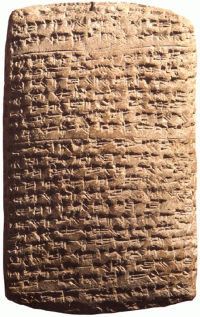The Amarna Letters
The Amarna Letters are a collection of several hundred pieces of correspondence between two Egyptian pharaohs and various leaders of other Middle Eastern civilizations in the 13th Century B.C. A chance discovery by an Egyptian woman in 1887 unearthed a handful of the clay tablets onto which the cuneiform was carved. The woman was searching for fertilizer and found evidence of a famous lost city. The tablets were submerged in the mud at what had been Amarna, the ancient royal capital of the pharaoh Akhenaten. Subsequent archaeologists, including the noted Egyptologist Sir William Flinders Petrie, found hundreds more. 
Historians know much more about the trade, customs, and communication between these ancient nations from what has been found in these carvings. The letters are also notable for the script that was used, that of the Akkadian culture, not of the people doing the carving. This was the language most used by the people in those places at that time period. It is significant that the Egyptian leaders used that language as well. Canaanite scribes addressed the letters not only to Akhenaten but also to Tutankhamen (who, as Akhenaten's son, was the heir apparent at the time). A further collection of letters mentioned Akhenaten's father, Amenhotep III. Some of the correspondence implores the pharaohs for assistance in turning back attacks by neighboring civilizations, including the Hittites and the Mittani. One particularly prolific ruler was Rib-Hadda of Byblos, who sent 58 letters asking Egypt for military help against the Hittites and other belligerents. Another well-known monarch represented in the Letters was the Mittani king Tushratta. The communication was not all one-way: Both Amenhotep III and Akhenaten wrote letters in return. However, they offered help rarely. Some evidence points to powerful women having a say in this correspondence. Nefertiti, Akhenaten's royal queen, answered a few letters, apparently because her husband was too involved with the affairs of state. Archaeologists have also found evidence that at least one of the letters was addressed directly to Queen Tiy, royal wife of Amenhotep III. |
|
Social Studies for Kids
copyright 2002–2025
David White




